10 Interesting Facts about Giant Panda
How did an animal with no particular historical significance in china, that no westerner had ever heard of before 1869 or seen alive until 1916, became a cultural demi-god? Except for its adorable appearance, what makes giant panda the most charismatic of the mega vertebrates?
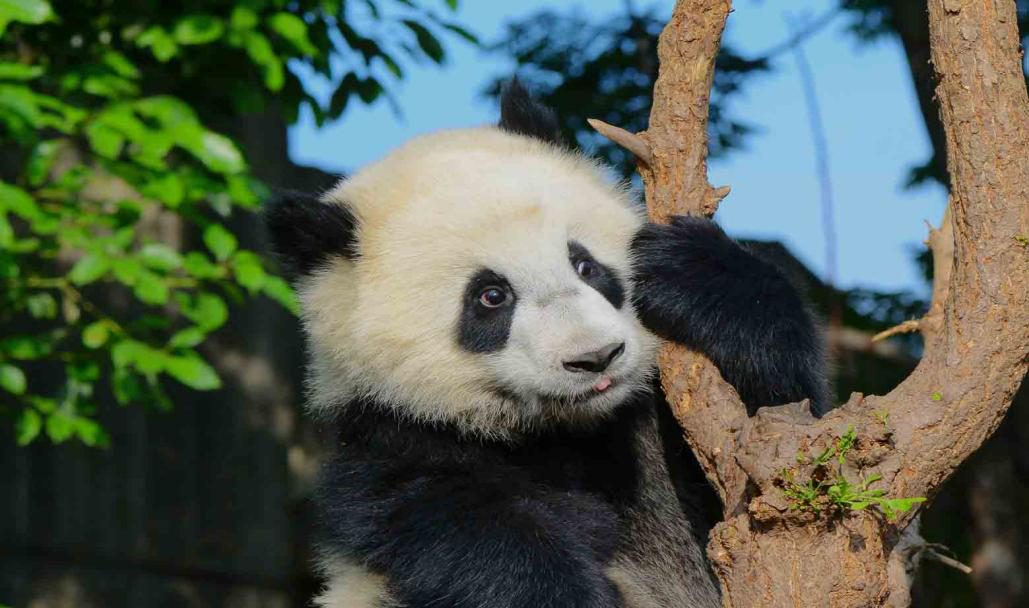
The magic of Giant Panda---seven identities of giant panda
1. Philosoper of black and white
No other animals have fascinated so many people as pandas. People, regardless of their gender, age, color, nationality, language or faith, become easily overwhelmed by their mystery and natural beauty. The credit, it is said, is partially given to their colors. Their black and white markings, two prime colors of the universe, are vivid and natural, symmetric and harmonious, and mysteriously distributed. The pattern and composition, resembling the Chinese philosophy of yin and yang and coinciding with the Taji diagram of Chinese Taoism, bring people a sense of natural ease, a pleasure both to the eye and mind.
The beautiful black and white pattern of giant pandas is extraordinary. The two colors, while in shining contrast, are in perfect balance. Pandas are adorned with innocent faces like children with adorable black eye circles, resembling the Chinese character of number eight.(八). Pandas have a pair of round black furry ears and broad shoulders. They look simple and harmonious as a whole, naturally formed and perfect in every way.
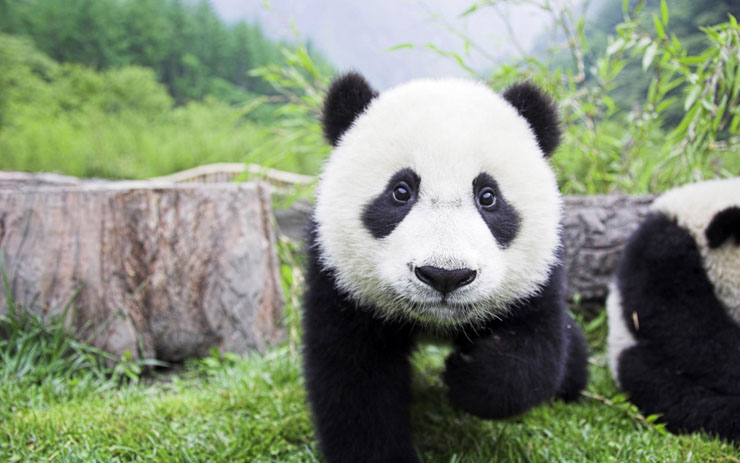
The layout of black and white markings corresponds closely to the philosophy of yin and yang in Chinese Taoism. They are in sharp contrast , while naturally connected , simple but profound. This is verified by the Taji diagram of traditional Taoist culture.
2. Great forest recluse
In ancient China, hermits were believed to be those who armed with great wisdom, saw through the emptiness of the material world and retreated to mountain forests. They shunned public life to lead a life of serenity in either temples with the companionship of a lone light, or remote mountain forests where they ate only simple food and found a complete escape from civilization.
In Chinese culture, giant pandas are often compared to hermits. They seem to understand the essence of life while braving changes over eight million years. They hide on high mountains where few people have ever ventured. They feed primarily on bamboo, seemingly diminished in desires just like that of a hermit. They are muscular and powerful but even-tempered, largely concerned only with their own affairs. They live in utter solitude in the company of flowing mountain springs and the shiny stars at night all the year round. Don't they resemble real hermits?

3. Motional and motionless kungfu master
In the eyes of many people, pandas appear slow and clumsy. Standing at a height of 1.7 meters and weighing on average 118kg (males) or 97 kg (females) , they seem to walk slowly and eat bamboo gently all the time. So, it is hard for people to imagine that they are actually agile and strong.
Scientists believe that because they eat bamboo which is low in nutrient content, they slow down to save energy. Some non-experts say that pandas are foolish and lazy. As a matter of fact, this is a misconception. Pandas are mostly sedentary but also move frequently. Big and heavy as they are, pandas are perfect climbers. In the wild, high trees mot only protect them against predators but also give them excellent resting places. In trees, they can breathe fresh air, enjoy warm sunshine, and have a commanding view of the mountains while keeping informed of what is happening around them.
When panda are at rest, they appear calm and peaceful. If they feel danger or if they feel happy, they can run faster than young humans. They are more capable than humans in their amazing ability to climb trees, cross rivers and clamber up mountain cliffs in dense forests. Panda fine-tune their movement and rest to most efficiently maximize their limited nutritional resources. In the philosophy of Chinese kungfu, those who practice martial arts have to “stand like a pine, sit like a bell, and walk like a breeze” before they become kungfu masters. It is as if pandas have also endorsed this philosophy in their life.
4. Peace and friendship ambassador
The giant pandas’ survival strategy reflects Taoist philosophy. A Taoism doctrine goes "the sage tries his best to benefit all and contend with none". Pandas eat bamboo and inhabit high mountainous areas, rarely struggling for food against humans or other animals. With large and strong bodies not unlike those of predators with sharp claws like tiger and other bears, they are however good-natured and non-offensive. They avoid the affairs of others and conform to the natural ways of things. Pandas are like non-verbal philosophers. They assert themselves perfectly by practicing minimal action. With their peacefulness, mystery and legends, they are made ambassadors of peace and friendship.
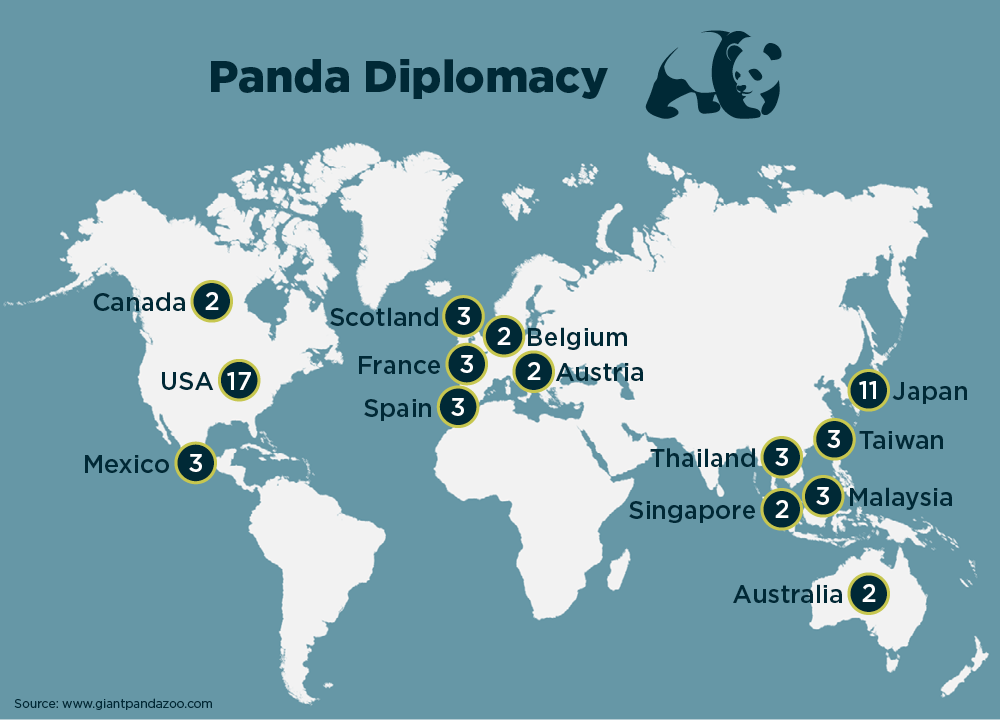
5. Lifelong learner
As they are destined to live a solitary existence when they grow up, they have a lot to learn in the course of their early growth. Luckily, young pandas are fast learners.
extremely curious and interesed in everything, young pandas often learn actively of their own initiative cubs over four months old, who are able to locomote independently, will begin to inquire about their surroundings, exploring trees, flowers, grass, bamboo thickets and pools. they probe into everything they can find.
Adult gps are extremely solitary. Because they live alone, there are many life skills for them to learn ,like how to eat bamboo, find water, avoid dangers, mate and raise their babies. Without continued learning, their chances of survival are very slim.
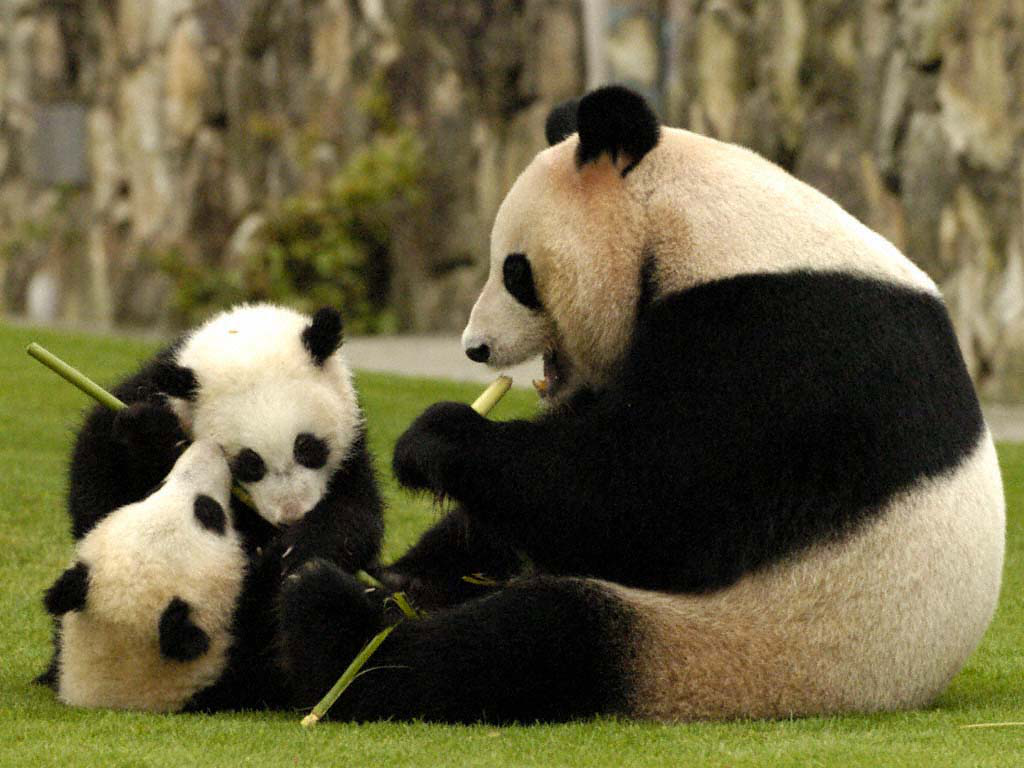
6. Wise vegetarians
Panda eat a vegetarian diet despite their short digestive tract, being only five to six meters long on average, and similar to that of carnivores such as tigers, leopards or wolves. Bamboo accounts for over 99% of their diet. Pandas in the wild eat more than 60 varieties of bamboo with about 27 species being favored. Bamboo, a fast growing plant, is widespread in mountains and valleys. Bamboo shoots, leaves, and culm constitute an endless supply of food. It may have been due to the turn from a carnivore diet to bamboo-eating that pandas have survived eight million years of evolution.
Bamboo has a low nutritional content so pandas are quite selective about the bamboo they choose to consume. They spend more than 10 hours a day feeding. To supplement their diet they occasionally enjoy a variety of wild plants like the Chinese gooseberry or wild parsnips. How pandas grow quickly from a weak, tiny, cub to sturdy animals by feasting mainly on bamboo, the nutritional content of which is almost negligible compared with high calorie foods consumed by humans and other species, is an amazing feat of evolution. Panda is surely a miracle of life.
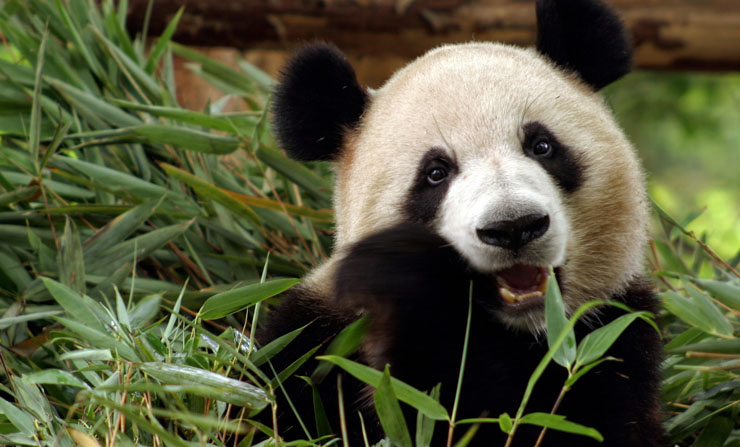
7. Territorial creatures
The territory of a wild panda varies from season to season. It depends on how difficult it is to look for food. In winter, it is not easy to find fresh and nutritious bamboo. They have to spend more time and travel a long distance. Sometimes in the wild, encounter with outsiders are unavoidable as their territory sometimes overlaps. In general, they do not fight but keep away from each other. Pandas are reluctant to leave their home. Once they establish their territory, they rarely move elsewhere except in the case of natural catastrophes or human induced disturbances. It is interesting that they are so attached to their territory.

8, On loan ambassador
It's actually not true that all pandas outside of China are on loan. The only exception is in Mexico. Mexico owns two living giant pandas - Shuan Shuan and Xin Xin in Chapultepec Zoo. China and Mexico also agreed that any offspring of them will belong to China but will stay in Mexico forever (and for free).That's the only exception. This exception happens because China gave 23 pandas to different countries before 1982. Only the couple in Mexico managed to breed offspring.
Another interesting fact is Xin Xin's father, Chia Chia is the panda on the logo of WWF. Chia Chia was gave to London Zoo at first but was loaned to Mexico after his companion Ching Ching died in London.
9, Releasing panda to the wild nature
In the panda wild training base in Wolong, pandas are trained their to get used to the life in the wild. The keepers there have to wear a panda suit smeared with panda urine while around panda in the hope that it would help him adapt to the wild. Some captive baby panda even have never seen a human face since being born. Panda releasing is a step-by-step process. For example, the panda in the picture Tao Tao was born in 2010 at a panda wild training base in Wolong, southwest China's Sichuan Province. When he was six months old he and his mother Cao Cao were moved into a large mountainous area for intensive wild habitat training. When that was a success the pair were moved to an even wilder area where they had more freedom. Keepers now plan to release Tao Tao fully into the wild in November. To keep track of him in the wild, and see how well he is adapting, Tao Tao has been fitted with a traceable ID chip and a GPS collar. And the whole training process was monitored closely from a distance.

Keeper wearing costumes carrying TaoTao back to base
While Tao Tao will be the first to ‘graduate’ from the programme, there are a number of other pandas who are now entering the final stage of their training and are expected to be released back into the wild next year.

10, Sexless panda
Pandas are known to be isolated creatures and poor breeders, and in captivity the problem may be exacerbated. One of the challenges facing institutions around the world is to have pandas breed naturally.
It truly seems an enviable existence to be a panda, spending up to 16 hours a day eating, eight hours a day sleeping, and almost zero hours moving. But during mating time, the panda's life gets a little more complicated. Most male pandas in captivity would rather lie around and chew bamboo than stand up and get busy. In another word, pandas are more interested in eating rather than having sex.
“The mating time is generally not so long. Sometimes several minutes. The shortest may be 30 seconds," said Zhang Zhihe, director of Chengdu Research Base of Giant Panda Breeding in Chengdu, China. "If they don't like the female's personality or the females don't like the male's personality, they won't mate. That's the biggest reason why in captivity the mating is difficult."
The panda breeding centers have tried a number of measures to try to cure the male panda of his woefully low libido -- including showing videos of fellow pandas making love. Along with watching porn, pandas are doing "sexercises," or specialized exercises to strengthen the males' hind legs and increase their stamina. Scientists have found that the combination of porn, exercises, and the occasional manage a trios -- to get young male pandas curious about sex -- have proved successful.
Please click here and check AbsolutePanda's Panda Excursions.

The magic of Giant Panda---seven identities of giant panda
1. Philosoper of black and white
No other animals have fascinated so many people as pandas. People, regardless of their gender, age, color, nationality, language or faith, become easily overwhelmed by their mystery and natural beauty. The credit, it is said, is partially given to their colors. Their black and white markings, two prime colors of the universe, are vivid and natural, symmetric and harmonious, and mysteriously distributed. The pattern and composition, resembling the Chinese philosophy of yin and yang and coinciding with the Taji diagram of Chinese Taoism, bring people a sense of natural ease, a pleasure both to the eye and mind.
The beautiful black and white pattern of giant pandas is extraordinary. The two colors, while in shining contrast, are in perfect balance. Pandas are adorned with innocent faces like children with adorable black eye circles, resembling the Chinese character of number eight.(八). Pandas have a pair of round black furry ears and broad shoulders. They look simple and harmonious as a whole, naturally formed and perfect in every way.

The layout of black and white markings corresponds closely to the philosophy of yin and yang in Chinese Taoism. They are in sharp contrast , while naturally connected , simple but profound. This is verified by the Taji diagram of traditional Taoist culture.
2. Great forest recluse
In ancient China, hermits were believed to be those who armed with great wisdom, saw through the emptiness of the material world and retreated to mountain forests. They shunned public life to lead a life of serenity in either temples with the companionship of a lone light, or remote mountain forests where they ate only simple food and found a complete escape from civilization.
In Chinese culture, giant pandas are often compared to hermits. They seem to understand the essence of life while braving changes over eight million years. They hide on high mountains where few people have ever ventured. They feed primarily on bamboo, seemingly diminished in desires just like that of a hermit. They are muscular and powerful but even-tempered, largely concerned only with their own affairs. They live in utter solitude in the company of flowing mountain springs and the shiny stars at night all the year round. Don't they resemble real hermits?

3. Motional and motionless kungfu master
In the eyes of many people, pandas appear slow and clumsy. Standing at a height of 1.7 meters and weighing on average 118kg (males) or 97 kg (females) , they seem to walk slowly and eat bamboo gently all the time. So, it is hard for people to imagine that they are actually agile and strong.
Scientists believe that because they eat bamboo which is low in nutrient content, they slow down to save energy. Some non-experts say that pandas are foolish and lazy. As a matter of fact, this is a misconception. Pandas are mostly sedentary but also move frequently. Big and heavy as they are, pandas are perfect climbers. In the wild, high trees mot only protect them against predators but also give them excellent resting places. In trees, they can breathe fresh air, enjoy warm sunshine, and have a commanding view of the mountains while keeping informed of what is happening around them.
When panda are at rest, they appear calm and peaceful. If they feel danger or if they feel happy, they can run faster than young humans. They are more capable than humans in their amazing ability to climb trees, cross rivers and clamber up mountain cliffs in dense forests. Panda fine-tune their movement and rest to most efficiently maximize their limited nutritional resources. In the philosophy of Chinese kungfu, those who practice martial arts have to “stand like a pine, sit like a bell, and walk like a breeze” before they become kungfu masters. It is as if pandas have also endorsed this philosophy in their life.
4. Peace and friendship ambassador
The giant pandas’ survival strategy reflects Taoist philosophy. A Taoism doctrine goes "the sage tries his best to benefit all and contend with none". Pandas eat bamboo and inhabit high mountainous areas, rarely struggling for food against humans or other animals. With large and strong bodies not unlike those of predators with sharp claws like tiger and other bears, they are however good-natured and non-offensive. They avoid the affairs of others and conform to the natural ways of things. Pandas are like non-verbal philosophers. They assert themselves perfectly by practicing minimal action. With their peacefulness, mystery and legends, they are made ambassadors of peace and friendship.

5. Lifelong learner
As they are destined to live a solitary existence when they grow up, they have a lot to learn in the course of their early growth. Luckily, young pandas are fast learners.
extremely curious and interesed in everything, young pandas often learn actively of their own initiative cubs over four months old, who are able to locomote independently, will begin to inquire about their surroundings, exploring trees, flowers, grass, bamboo thickets and pools. they probe into everything they can find.
Adult gps are extremely solitary. Because they live alone, there are many life skills for them to learn ,like how to eat bamboo, find water, avoid dangers, mate and raise their babies. Without continued learning, their chances of survival are very slim.

6. Wise vegetarians
Panda eat a vegetarian diet despite their short digestive tract, being only five to six meters long on average, and similar to that of carnivores such as tigers, leopards or wolves. Bamboo accounts for over 99% of their diet. Pandas in the wild eat more than 60 varieties of bamboo with about 27 species being favored. Bamboo, a fast growing plant, is widespread in mountains and valleys. Bamboo shoots, leaves, and culm constitute an endless supply of food. It may have been due to the turn from a carnivore diet to bamboo-eating that pandas have survived eight million years of evolution.
Bamboo has a low nutritional content so pandas are quite selective about the bamboo they choose to consume. They spend more than 10 hours a day feeding. To supplement their diet they occasionally enjoy a variety of wild plants like the Chinese gooseberry or wild parsnips. How pandas grow quickly from a weak, tiny, cub to sturdy animals by feasting mainly on bamboo, the nutritional content of which is almost negligible compared with high calorie foods consumed by humans and other species, is an amazing feat of evolution. Panda is surely a miracle of life.

7. Territorial creatures
The territory of a wild panda varies from season to season. It depends on how difficult it is to look for food. In winter, it is not easy to find fresh and nutritious bamboo. They have to spend more time and travel a long distance. Sometimes in the wild, encounter with outsiders are unavoidable as their territory sometimes overlaps. In general, they do not fight but keep away from each other. Pandas are reluctant to leave their home. Once they establish their territory, they rarely move elsewhere except in the case of natural catastrophes or human induced disturbances. It is interesting that they are so attached to their territory.

8, On loan ambassador
It's actually not true that all pandas outside of China are on loan. The only exception is in Mexico. Mexico owns two living giant pandas - Shuan Shuan and Xin Xin in Chapultepec Zoo. China and Mexico also agreed that any offspring of them will belong to China but will stay in Mexico forever (and for free).That's the only exception. This exception happens because China gave 23 pandas to different countries before 1982. Only the couple in Mexico managed to breed offspring.
Another interesting fact is Xin Xin's father, Chia Chia is the panda on the logo of WWF. Chia Chia was gave to London Zoo at first but was loaned to Mexico after his companion Ching Ching died in London.
9, Releasing panda to the wild nature
In the panda wild training base in Wolong, pandas are trained their to get used to the life in the wild. The keepers there have to wear a panda suit smeared with panda urine while around panda in the hope that it would help him adapt to the wild. Some captive baby panda even have never seen a human face since being born. Panda releasing is a step-by-step process. For example, the panda in the picture Tao Tao was born in 2010 at a panda wild training base in Wolong, southwest China's Sichuan Province. When he was six months old he and his mother Cao Cao were moved into a large mountainous area for intensive wild habitat training. When that was a success the pair were moved to an even wilder area where they had more freedom. Keepers now plan to release Tao Tao fully into the wild in November. To keep track of him in the wild, and see how well he is adapting, Tao Tao has been fitted with a traceable ID chip and a GPS collar. And the whole training process was monitored closely from a distance.

Keeper wearing costumes carrying TaoTao back to base
While Tao Tao will be the first to ‘graduate’ from the programme, there are a number of other pandas who are now entering the final stage of their training and are expected to be released back into the wild next year.

10, Sexless panda
Pandas are known to be isolated creatures and poor breeders, and in captivity the problem may be exacerbated. One of the challenges facing institutions around the world is to have pandas breed naturally.
It truly seems an enviable existence to be a panda, spending up to 16 hours a day eating, eight hours a day sleeping, and almost zero hours moving. But during mating time, the panda's life gets a little more complicated. Most male pandas in captivity would rather lie around and chew bamboo than stand up and get busy. In another word, pandas are more interested in eating rather than having sex.
“The mating time is generally not so long. Sometimes several minutes. The shortest may be 30 seconds," said Zhang Zhihe, director of Chengdu Research Base of Giant Panda Breeding in Chengdu, China. "If they don't like the female's personality or the females don't like the male's personality, they won't mate. That's the biggest reason why in captivity the mating is difficult."
The panda breeding centers have tried a number of measures to try to cure the male panda of his woefully low libido -- including showing videos of fellow pandas making love. Along with watching porn, pandas are doing "sexercises," or specialized exercises to strengthen the males' hind legs and increase their stamina. Scientists have found that the combination of porn, exercises, and the occasional manage a trios -- to get young male pandas curious about sex -- have proved successful.
Please click here and check AbsolutePanda's Panda Excursions.
Last one: Panda Habitat
Next one: Yunnan Diary
 info@absolutepanda.com
info@absolutepanda.com






